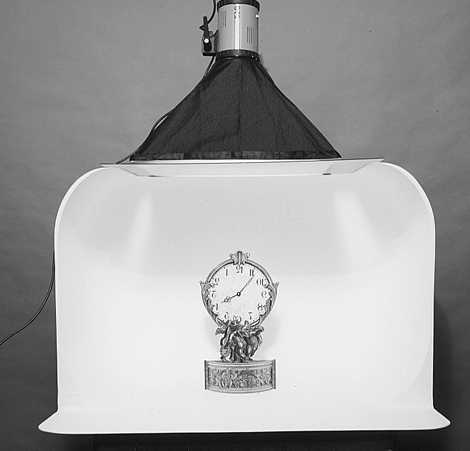

Above: By placing a sheet of perspex or glass over the top of the minicove, it is possible to position a small soft-box without the need for additional support.
The same approach can also be used for smaller scale shoots thanks to Colorama Photodisplay's Minicove, which is a far more sensible purchase option. Just like the best full-size versions, the mini-cove wraps around in three dimensions, at the sides as well as above and below. It is relatively light but rather bulky at 27 x 32 x 41". The shell is fibre-glass and the cost is �295 plus VAT.
In use, the mini-cove is totally successful in what is does. A sheet of glass or clear perspex placed across the top opening allows a small soft-box to be placed above and shone in without any need for further support. Fall-off is only slight thanks to the white reflecting walls and large light source. To ensure a clean background, the mini-cove should be painted before use and whenever it starts to look a little dirty. Ordinary emulsion is best, taking less than fifteen minutes to renew the cove's brilliant white.
Metering isn't easy, but once correct exposure has been established it can be taken as reasonably constant (though subject to magnification corrections when photographing objects of different sizes). The clock shown here needed no such correction and was exposed at �16 on ISO 100 film with the soft-boxed Prolinca 250 head set to half power.
The larger flower study also illustrates the accompanying Bowens Esprit test and was shot using the mini-cove. In this case, the cove was turned on its end to accommodate the height of the amaryllis. A sheet of tracing paper was taped over the cut-out area and an Esprit 500 was shone in through this. A flat white reflector board was positioned to the left, closer than the far wall of the cove, just out of camera sight. The exposure was made at �11 with the head set to one-eighth power.
As is the case with full-size coves, once you've used the mini-cove you won't want to go back to shooting against paper scoops. There is simply no comparison between the two: Colorama's mini-cove is THE professional choice.
Jon Tarrant